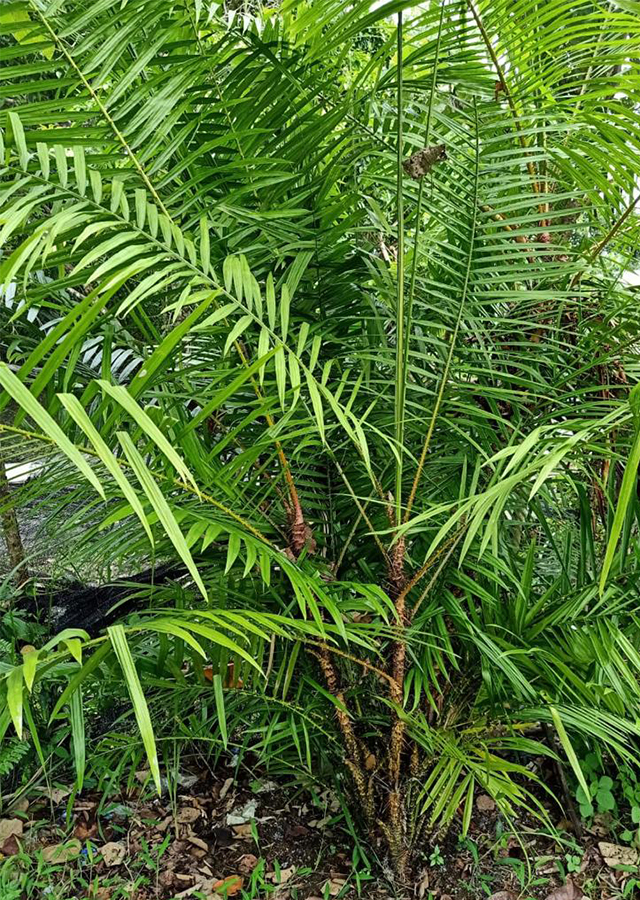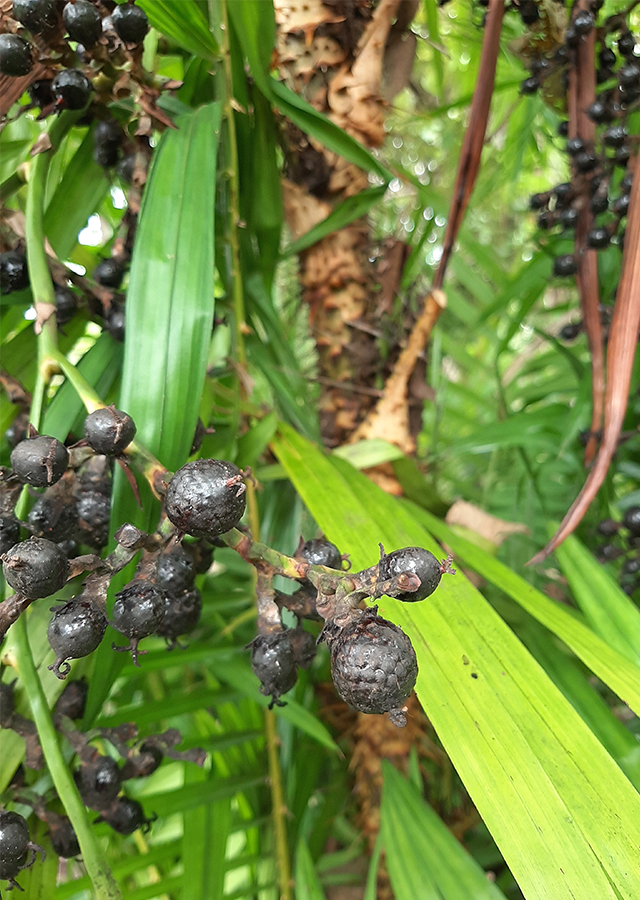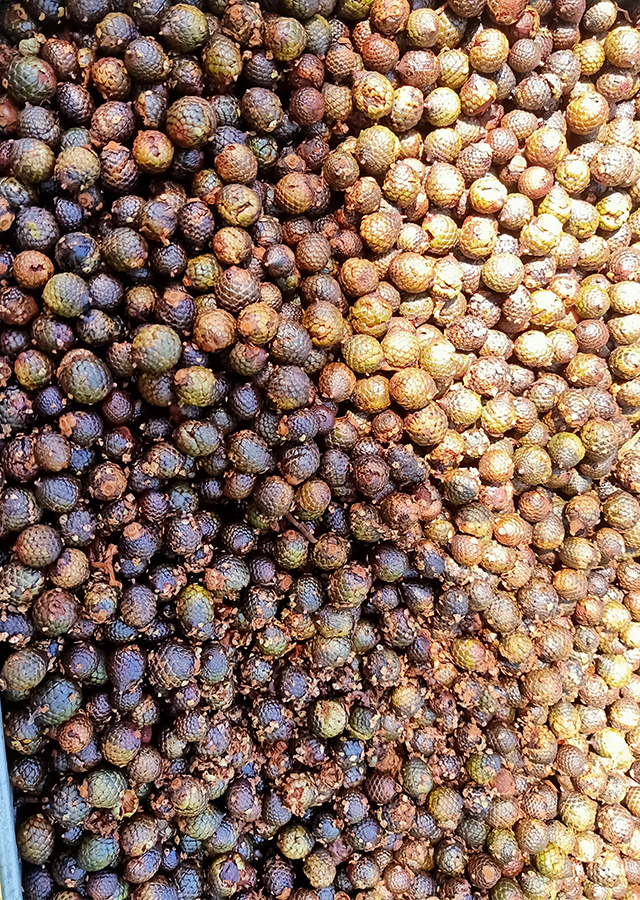Dragon's Blood
Calamus draco Willd.
Arecaceae
Location in our garden
Orchard



Synonym
Calamus draconis Oken
Daemonorops draco (Willd.) Blume
Palmijuncus draco (Willd.) Kuntze
Habitus
Palm. An evergreen climbing perennial palm, unbranched stems up to 15 m long
Part Used
Fruit
Resin
Growing Requirements
Need Shade
Habitat
Forest
Overview
Dragon's blood is native to Indonesia (Sumatra and Kalimantan), Malaysia, and Thailand. Since their distribution seems only limited to part of western South-East Asia, they are said to be endemic to that region. The unripe fruit from female flower produces deep red resin. It has been long used by some indigenous tribes in Sumatra-Talang Mamak and Anak Dalam or Kubu tribes. Dragon's blood has been used for diverse medical and artistic applications.
Vernacular Names
Longxuejie (Chinese), Kirin-kakketsu (Japanese), Wi ondo (Malay), Rotan jernang (Indonesia).
Agroecology
C. draco is a plant of moist lowland areas. This species can be found in hill slope and valley bottom on lower montane primary forest up to 1,000 m altidtude. They grow best in a humus-rich soil, with their roots in the shade but with enough gap in the canopy to encourage their stems to grow up towards the light.
Morphology
- Stems - without sheaths c. 15 mm in diameter, with sheaths up to 30 mm in diameter, internodes to 20 cm long. Leaf sheaths bright green, bearing chocolate-coloured indumentum when young. Knee well developed, armed with scattered black spines, to 20 mm long; ocrea absent.
- Leaves - cirrate, to 2.5 m long including the petiole to 30 cm and cirrus to 1 m long leaflet is irregularly arranged at the upper half, regularly arranged below, up to 20 on each side, leaflets linear lanceolate, 37 cm long, and 4 cm wide, at the margins blackish bristly.
- Flowers - inflorescence pendulous, up to 51 cm long, peduncle 9 cm long, armed along the margin with short spines, ellipsoid oblong.
- Fruits – ovoid, 28 x 20 mm, covered by 16 10 scales arrange in vertical rows, broad, 1.3 x 1.3 cm, dark reddish line in the middle of scales, scattered with dragon's blood. Fruit from female flower produce resin.
- Seeds - ovate oblong, 1 x 0.7 cm, reticulate on half surface and the other half deep rugose surface.
Cultivation
Propagated by seeds (generative propagation). Draco seedling from cultivation usually produces male plant, while wild plant was found as female plant.
Chemical Constituents
Dracorhodin, dracorubin, dracooxepine, dracoalban, dracoresene, dracoresinotannol, dracoflavan A, dracoflavan, nordracohobin, nordracorubin, abietic acid, dehydroabietic acid, isoprimaric acid, pimaric acid, sandaracopimaric acid, benzoic acid, secobiflavanoid, dammaradienol.
Traditional Medicinal Uses
- Its natural antioxidant is required as a free radical scavenger and able to prevent the human body from any kind of oxidative damages.
- The resin has been used in dentifrices and as a mouth wash. It is astringent and stimulant. Internally, it is used to alleviate chest pains, post-partum bleeding, internal traumas, and menstrual irregularities. In Indonesia, it is used for healing a wound, headache, and even fever by Anak Dalam tribe.
- The cane appears to be of good quality.
Part Used
Reference Sources
- Asra R, Syamsuardi, Mansyurdin, Witono JR. 2012. Rasio seks jernang (Daemonorops draco (Willd.) Blume) pada populasi alami dan budidaya: implikasi untuk produksi biji. Buletin Kebun Raya 15(1): 1-9. Diambil dari https://publikasikr.lipi.go.id/index.php/buletin/article/view/111.
- Tropical Plants Database, Ken Fern. (2014). Daemonorops draco. http://tropical.theferns.info/viewtropical.php?id=Daemonorops+draco. 17-08-2020.
- Gupta, D., Bleakly, B., and Gupta, R.K. (2008). Dragon's blood: Botany, chemistry and therapeutic uses. Journal of Ethno-Pharmacology, (115) (pp361-380).
- Royal Botanic Gardens. (No date). Plants of the World Online: Calamus draco Willd. http://powo.science.kew.org/taxon/urn:lsid:ipni.org:names:665061-1. 17-08-2020.
- Pl@nt Use. (2016). Daemonorops draco (PROSEA). https://uses.plantnet-project.org/en/Daemonorops_draco_(PROSEA). 17-08-2020.
- Purwanti, S., Wahyuni, W.T., and Batubara, I. (2019). Antioxidant Activity of Daemonorops draco Resin, Journal of Scientific and Applied Chemistry, 22 (5) (pp179-183).


